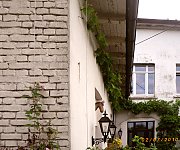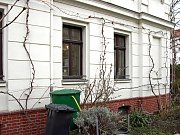Plastered Solid Brick
Solid plastered brick walls are a classic example of plastered masonry and show up on typical 'old buildings' built before 1930. Solid ("full" bricks) - without any hollows - were used. All cable trellis kits from FassadenGrün can be used on such walls as long as you are not dealing with a special plaster facade. Drilling can sometimes be problematic. See the bottom of the page for tips.
Properties of this Masonry
Plastered masonry made of solid bricks is found especially on buildings from the Wilhelminian Period (in Germany 1890-1918), but also on even older buildings and those built up to 1930. The chief characteric is the massive bricks without holes ('perforations'). From about 1930 onwards, bricks with perforations were increasingly used, at first mainly to make the building lighter and to save material. (Plastered walls with such hollow bricks are considered in a separate section.) For pre-1850 buildings, there is almost always half-timbering also under the plaster. Learn more about this under historic masonry. Plaster layers of solid brick buildings are usually about 2 cm thick. With profiles/mouldings, it can even be twice as much and more (see special plasters.) Old and brittle joints can also be an issue. In the past, cement was expensive and the mortar was sometimes only used sparingly.
Suitable Mounts, Plugs, and Drill Bits
Basically all 5 construction styles from FassadenGrün- and their respective standard mounts- are suitable, but our Easy version is only compatible under certain conditions (as described under "
Common problems with plastered walls
." Any of the drill bits we provide can be used. For highly brittle joints, we recommend rawlplugs without expansion pressure (adhesion with composite mortar)- for example, by gluing the plugs in first before screwing the mounts into them.Drilling into plastered solid brick
Test the condition of the plaster by gently tapping on it. Hollow sounding areas indicate low load-bearing capacity and will likely need to be replastered before you can drill and mount. Keep an eye on the depth at which you encounter the load-bearing stone layer. After passing through the plaster layer, you will know when you have reached the brick by the colour of the drill dust. (For plaster thicker than 2 cm, refer to our page dedicated to special plasters.) Please also refer to our drill bit assortment and our tips on drilling.

Building made of solid brick from the early 20th century, wire rope trellis system in our Medium Classic construction, thicket creeper


